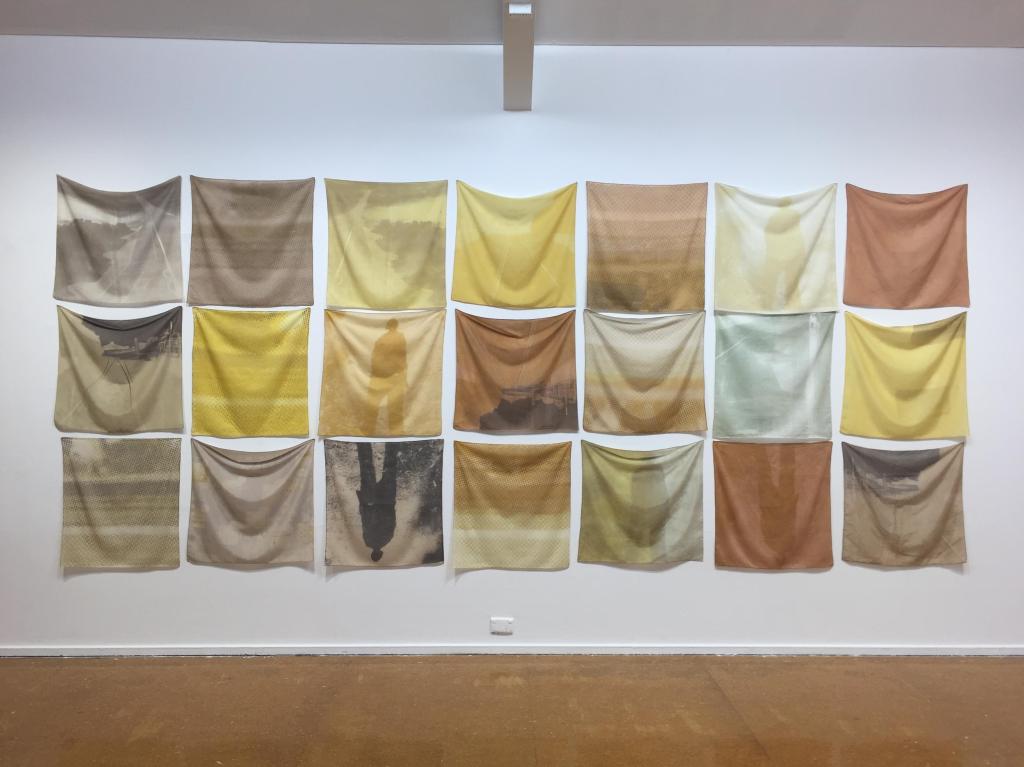Rebecca Mayo, Escape route: Melbourne to Canberra (2018), installation view Canberra Contemporary Art Space (2109); courtesy the artist; photo Artshub.
While the noise tends to be amplified around our majors, spaces like Canberra Contemporary Art Spaces (CCAS) are vital platforms for local artists to show their work within a broader national ecosystem.
The current exhibition at CCAS is a great example – cross-generational, collaborative in part, edgy and erudite, it is an exhibition that steps up in its presentation, despite a building that is looking rather shabby.
Unfinished Business has filled a timeslot that had been earmarked for the closing exhibition of CCAS at Gorman Arts Centre in Braddon, where it has resided since the mid 1980s.
However a jostle over breaking a lease has forced the independent gallery to stay another six months, before moving down to the shores of Lake Burley Griffith in February 2020, to take up residence at Reconciliation Place with neighbours the National Gallery of Australia, the National Portrait Gallery and the National Library of Australia. All this ahead of a move to the planned Kingston Arts Precinct.
CCAS Curator Alexander Boynes told ArtsHub that the relocation ‘puts Canberra artists on their doorstep’. CCAS will have a 3 year + 1 + 1 lease on the space, which has largely had itinerant occupants, since it was built in 2001.
Boynes has curated the current exhibition which brings together three contemporary artists based in the ACT region – and indeed all hold academic positions with ANU School of Art & Design – and yet this is their first show at CCAS.
While on first glance the work of exhibiting artists Peter Alwast, Nigel Lendon and Rebecca Mayo is quiet disparate, Boynes has drawn them together from a formalist perspective – their use of the grid, of multiples, of distilled aesthetic for conceptual conversations.
The highlight of this exhibition is the work by Mayo, three separate series that work beautifully in the space. Bound by Gorse (Ulex europaeus) (2017) presents a pile of bricks that have been made from the introduced weed Gorse, commonly used for suburban hedging.
Using a laborious handmade paper technique to transform the weeds into bricks, it is an elegant conceptual conversation with the weed’s tedious process of removal and its function to replace bricked boundaries.

Rebecca Mayo, Bound by Gorse (Ulex europaeus) (2017), installation view Canberra Contemporary Art Space (2109); courtesy the artist; photo Artshub
It sits alongside Plastic Bags (2019) a suite of delicate faux plastic shopping bags made from silk and natural dyes. They delicately hover off the wall in a comment on environmental fragility and ephemerality.
In the main space, another work that floats pinned to the wall and made with natural dyes on silk – of which one is that infamous Gorse weed – in a multi-tile narrative that talks about the artist’s personal perpetual flight between Melbourne and Canberra – symptomatic of this national capital.
It works beautiful with Lendon’s minimal work, Even. And. But. Also (1969-2019) which plays with the arrangement of L-form elements down the long wall of the gallery. There is a sure sense of seriousness as well as play in this work, building on the sense of conundrum and consideration that contemporary art offers.
Nigel Lendon Left: Even, And. But. Also (1969-2019) powdercoated steel; LENDON/BEER Right: As Yet Untitled 2018:15; installation view Canberra Contemporary Art Space (2109); courtesy the artists photo Artshub
They make sense of two optical wall works, also made from powder-coated steel, in a smaller gallery painted black.
Known for often collaborating with other artists, sitting central to the space is a work he has created with Canberra artists Emma Beer, As Yet Untitled 2018:15. While one’s immediate read is the vernacular of exquisitely precise geometric abstraction in homage to a past history, on closer examination this installation breathes with a brushy irreverence, bridging it with its 21st century making.
Similarly, Alwast’s works feel like an anomaly at first, their layered collage and painting again referencing past art histories and making. However on closer interrogation, one starts to realise that pulling on those elements of hessian and oil pastel, for example, are fragments of digital media, splicing and refashioned in a way that talks to the kind of pace and filtering of our tech-heavy times.
Peter Alwast, Bank Tower (2018); installation view Canberra Contemporary Art Space (2109); courtesy the artist; photo Artshub
They are this great mash up – not until Mayo and Lendon’s works – that sit with a lightness in the space but have this depth to them.
Boynes believes that Alwast, Lendon and Mayo share generational overlaps in their practice. ‘These overlaps are not necessarily literal, but instead relate to their formal aesthetics, attitude and their mode of interpreting the world around them.’
Boynes, who grew up with artist parents and cut his teeth at CCAS, told ArtsHub that he felt there remained an enormous gap between our majors and small to medium organisations. His commitment to tightening that gap through exhibitions like this one – and especially with the gallery’s move – is especially vital to the cultural ecosystem of Canberra, which can be so easily overshadowed by national institutions, as opposed to ACT-funded one.
It is heartening that in the shadow of the muscle, serious contemporary practice is happening and exhibited.
Rating 3.5 out of 5 ★★★☆
Unfinished Business 31 May – 27 July
Canberra Contemporary Art Space
Curated by Alexander Boynes
Artists: Peter Alwast, Nigel Lenden, Rebecca May and Emma Beer.







